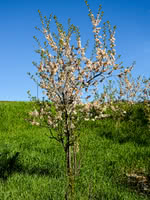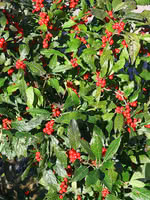Mon-Fri 9am - 5pm Mountain time
Canada Plum & American Plum vs Winterberry
Prunus nigra and americana
Ilex verticillata
CUSTOM GROW
Canada and American Plum are almost identical in appearance and growth needs. These plants are short and stout fruit trees native to North America.
This hardy ornamental is excellent for both city dwellings as well as rural areas. During the spring, the white and pink blossoms are long lasting. The tasty fruit is suitable for fresh eating, baking, and preserves. These trees are not widely distributed and pure seed can be hard to come by.
Both are commonly used as rootstock and are considered universal pollinizers for other plum varieties.
Winterberry is a small shrub that produces large quantities of bright red berries that remain on the plant through the fall and into the winter. Adding this shrub to your yard will give it a unique splash of color and attract birds, especially after the leaves drop.
Note: although the foliage is attractive on its own, you need at least one male plant near your female plants or they won't produce berries.

